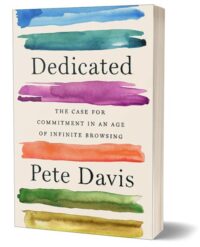
Dedicated to Building
When I first started writing this blog, I let people know about new posts through a newsletter I wrote using Mailchimp. For reasons which I can’t remember, we set up the newsletter so that it contained a link to a quick review of a book I had just read and a new site I had learned about as well as to the post itself.
Then, I switched to Substack, and there was no obvious way to include those features. Now, after reading Pete Davis, Dedicated, Eboo Patel, We Need to Build, I’ve realized that I should begin letting readers know about what I’m reading again. And, I figured out how to have those sections in my Substack feed even if they don ‘t look quite as slick as they did in my Mailchimp days.
You can read my capsule reviews of the two books by clicking the links below.
However, I want to use this post to use the key words in their titles to talk about how I hope to build a “connecting the dots” community.
Dedication for the Long Haul
Davis aimed his book primarily at young readers like himself. I, of course, reacted to it as an older activist but also as someone who lives in the same affluent suburb in Northern Virginia that he does, although we haven’t met yet.
He sees one thing that few in my generation thought about very much when we were his age. We faced what looked like short term problems. Some, like the war in Vietnam, could be ended quickly with seemingly simple decisions. We knew that others, like civil rights, could not be solved with a flurry of legislation such as the acts passed in 1964 and 1965. Still, few of us assumed that the issues we were taking on would consume us for the rest of our lives.
Davis and the other young activists I work with harbor no such illusions. His version of dedication involves a lot more than going to a string of demonstrations or making a series of financial contributions. We have to commit ourselves to being “in it” for the long haul.
I suspect that he’s right about the problems facing his generation in one key way. Social pressures from the Internet and pop culture lead to what he calls a culture of “infinite surfing,” the fear of missing out, and more, all of which seem to make it hard for his contemporaries make any kind of commitment, whether at home, at work, or in the public sphere.
But I suspect he misses the importance of the admittedly small number of his contemporaries who understand that they are making a life-long commitment to working for social change and living the entirety of their lives accordingly. These young people (and their counterparts in my generation and the ones in between) have dedicated their lives to social change which brings with it the need to both adapt to changing circumstances and find ways of maintaining their commitment when the times get tough as they invariably will.
| This Crossed My Desk | Check out Acquaint which is a cool new program that helps people talk to anyone, anywhere, at any time. |
|---|
Building New Norms and Institutions
That said, dedication is not enough, which is where Patel’s building comes into play on two levels,. Both start with dedication but neither can be achieved quickly or easily. Hence the need for building.
Both also involve going beyond the anger and protest I experienced as a new left activist and which I’ve sen in the streets since 2020. As many have argued, dissatisfaction with the status quo—whether it’s the war in Vietnam or the presidency of Donald Trump—may shake people up and get them to do something. Successful movements need much more. They need to convert that anger with the status quo iinto a vision of a better world that we can all work for.
First, that means that we have to go beyond the issues of the day and build support for new cultural norms that go deeper than the emotional reactions that we saw expressed in the tumult of 2020 and beyond. Equality along racial and gender lines. Sustainability. Innovation. Civility and tolerance. Democracy. This is not something we focused on either very consciously or very effectively in the 1970s. We did little to build bedrock support for a peaceful foreign policy or an anti-racist domestic strategy that could endure when the countries we were worried about or the specific manifestations of racism we were confronted with changed.
I did see hopeful signs that we have begun to learn those lessons in the last few years. Phrases like Black Lives Matter or hashtags like #MeToo are very vague and general. However, unlike the slogans and mobilizing tools we used back in “the day,” these lend themselves far better to other issues and to being generalized.
Second, as Patel argues even more strongly, we need to begin building new institutions in which those new values can be put into practice in ways that we can later build on. In my home field of peacebuilding, colleagues have enjoyed remarkable successes in communities around the world. Too often, however, they have not been able to either keep those successful initiatives going or build on them elsewhere.
Luckily, entrepreneurs and others in the startup world have drawn our attention to the ways that new practices and institutions can be taken to scale. That’s not something we thought about in the sixties in any depth. To be sure, part of my job as head of SDS (Students for a Democratic Society) at Oberlin my senior year was to try to expand out national network. However, we did next to nothing to strengthen our organization either on campus or nationally.
Now, I’m involved with three explicit attempts to build local networks and institutions that could be adapted for use anywhere in the United States.
- The Portland Peace Initiative is a working coalition of citizens who came together after the largest city in Oregon was rocked by protests in 2020, a history of police-community mistrust, and outbursts of gun violence. It includes the pastor of the city’s largest Black church, volunteers from Rotary clubs in the region, and national organizations like Police2Peace. It has brought together people from the community, local government, and civil society organizations to, for example, strengthen startups and civil society organizations run by members of the city’s BIPOC community. The most relevant thing to see here is that similar coalitions in other cities with somewhat different problems and presenting issues can take this basic model and adapt it.
- The TRUST Network is already a national network that was created by Mediators Beyond Borders, NAFCM, and others during the tumultuous months leading up to the 2020 presidential election. It is building local networks of mediators and others who can provide EWER (early warning, early response) services to communities where democracy and stability are under threat. Thus, it is forging more local networks whose goals overlap a good bit with the Portland Peace Initiative while also beginning to create national level institutions that can coordinate that work and find outlets for it in policy making circles in Washington.
- Zebras Unite chapters exist in thirty cities around the world, six of which are in the United States (including Portland; one in Washington DC, where I live, is being organized). As regular readers know, the Zebras are a founder owned, cooperatively led network of businesses seeking to create the capital, culture, and community for the next economy. The Zebras are in the process of integrating the local chapters with its own coop to create local pockets that could do for new economic ventures what the other two are doing in race relations and democratic engagement. Because the Zebra chapters reflect the individuals and organizations that choose to join in a given community, no two of them are remotely alike. As things stand now, the coop’s leadership will serve as a clearinghouse both for its own business-members and for the local chapters whose members may not all be a part of the formal coop.
In short, dedication and building to last are terms whose importance I’ve been aware of for quite some time. But Davis and Patel both sharpened my thinking in ways that will propel the work we do in connecting the dots forward.
The views and opinions expressed in this article are those of the author and do not necessarily reflect the official policy or position of the Alliance for Peacebuilding or its members.
Also published on Medium.


